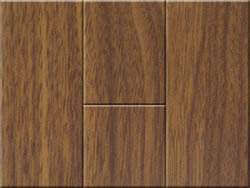Difference between Laminate and Veneer
Key difference: Laminates are a multi-layer synthetic flooring product. It is created high-density fiber, melamine resin or wood particles. On top, the laminate has a photographic applique layer, which is in turn covered with a clear protective layer. The photographic applique layer is usually imprinted with various images that aim to imitate the appearance of real wood. In case of laminated wood, the wood veneers are pasted parallel to each other, as opposed to the right angles in plywood. Veneer, on the other hand, refers to thin slices of wood that are practically peeled of the wood. The slices are usually less than 3 mm (1/8 inch) thick.
 Laminates are a multi-layer synthetic flooring product. It is created high-density fiber, melamine resin or wood particles. On top, the laminate has a photographic applique layer, which is in turn covered with a clear protective layer. The photographic applique layer is usually imprinted with various images that aim to imitate the appearance of real wood. In case of laminated wood, the wood veneers are pasted parallel to each other, as opposed to the right angles in plywood.
Laminates are a multi-layer synthetic flooring product. It is created high-density fiber, melamine resin or wood particles. On top, the laminate has a photographic applique layer, which is in turn covered with a clear protective layer. The photographic applique layer is usually imprinted with various images that aim to imitate the appearance of real wood. In case of laminated wood, the wood veneers are pasted parallel to each other, as opposed to the right angles in plywood.
Laminates are fairly new in the market, especially as compared to traditional wood. However, laminates have been steadily replacing wood, particularly in flooring. This is mainly because laminates provide the look of traditional wood for a fraction of the cost.
In addition to being cheaper, laminates are scratch-resistant, durable and easier to clean than traditional wood. It is easier to maintain, as the clear protective layer is resistant to pretty much everything except long exposure to water. This makes is longer lasting and well suited to be used in homes with kids and pets.
However, long time exposure to water or moisture may result in the laminate warping or ballooning. Laminates also tend to be thinner in size than wood. Moreover, the look of the laminate is set by the manufacturer, as opposed to wood that can be sanded and re-stained in any color of the stain available. Nonetheless, as the laminate is basically an image printed on it, the choice is pretty much limitless, and some manufacture may be willing to take custom orders. Still, laminates lack the visual warmth of wood.
Laminates also have a relatively shorter life-span as compared to traditional wood. The average life-span of laminate is between 10 to 20 years. It usually has a manufacturer warranty of 10 years. It is also very hard to repair laminates, if it is damaged in any way or has run its course, the entire thing will have to be replaced.
Another advantage to laminates is that they are environmentally friendly as they use less wood to be manufactured, if any at all.
 Veneer, on the other hand, refers to thin slices of wood that are practically peeled of the wood. The slices are usually less than 3 mm (1/8 inch) thick. The thin slices can then be glued together to create either laminated wood or plywood. Plywood typically consists of three or more layers of veneer.
Veneer, on the other hand, refers to thin slices of wood that are practically peeled of the wood. The slices are usually less than 3 mm (1/8 inch) thick. The thin slices can then be glued together to create either laminated wood or plywood. Plywood typically consists of three or more layers of veneer.
The veneer can also be glued onto core panels, such as wood, particle board or medium-density fiberboard. This gives the said wood, particle board or medium-density fiberboard, the look of the wood that the veneer was cut from. The veer covered wood, particle board or medium-density fiberboard can then be used to produce flat panels such as doors, tops and panels for cabinets, parquet floors and parts of furniture. Veneer beading is a thin layer of decorative edging placed around objects, such as jewelry boxes.
Veneer is usually obtained either by peeling the trunk of a tree or by slicing large rectangular blocks of wood known as flitches. There are three main types of veneer-making equipment used:
- Rotary lathe – in which the wood is turned against a very sharp blade and peeled off in one continuous or semi-continuous roll. This is mainly used for plywood.
- Slicing machine – in which the flitch or piece of log is raised and lowered against the blade and slices of the log are made. This type of veneer is also referred to as "crown cut" and looks like sawn pieces of wood.
- Half-round lathe - in which the log or piece of log can be turned and moved in such a way as to expose the most interesting parts of the grain.
There are many various types of veneer available in the market:
- Raw veneer – has no backing on it and can be used with either side facing up.
- Paper backed veneer – veneers that are backed with paper
- Phenolic backed veneer – less common. Mainly used for composite or manmade wood veneers.
- Laid up veneer – raw veneer joined together to make larger pieces.
- Reconstituted veneer – raw veneer cut and at times dyed. Usually made from fast-growing tropical species.
- Wood on Wood – decorative wood veneer face with a utility grade wood backer that is applied to the opposing direction to the face veneer. Also called 2-ply.
Image Courtesy: made-in-china.com, danzer.com









Add new comment